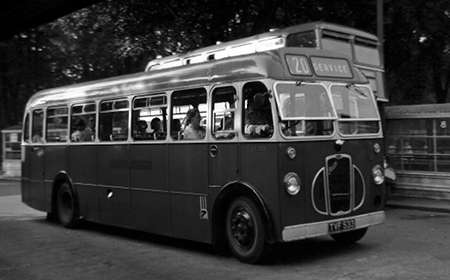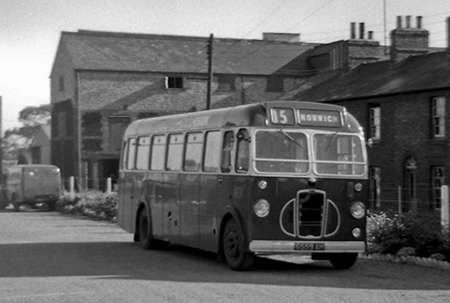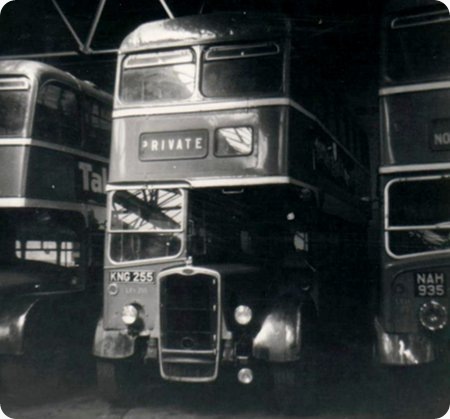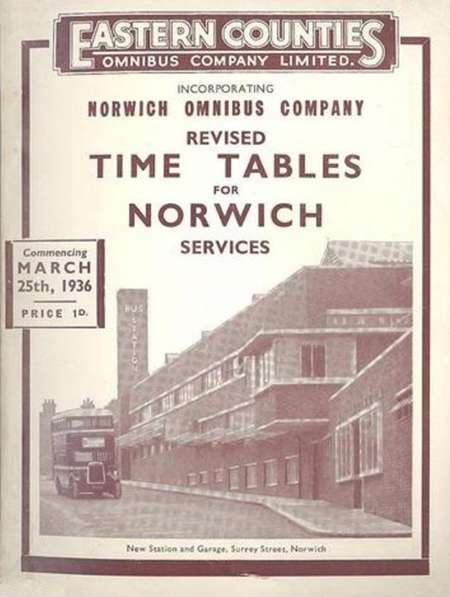Eastern Counties - Bristol SC4LK - VVF 540 - LC540
Eastern Counties Omnibus Company
1957
Bristol SC4LK
ECW B35F
Before researching the facts about the Bristol SC for this caption, I had somehow presumed that
Crosville would have been the largest customer for the type. In fact I was surprised to find that they
were only the third largest, having bought a total of 79. 323 were built altogether between 1954 and
1961, being supplied to nine BTC operators. Lincolnshire Road Car had the most with an amazing 113, and
Eastern Counties was in second place having bought 88.
One of the latter’s examples is shown here
preparing to depart the former Drummer Street Bus Station in Cambridge on 11th July 1970. LC540 (VVF
540) was an SC4LK with E.C.W. B35F body, new in 1957 and withdrawn in 1971.
Photograph and Copy contributed by John Stringer
06/10/13 - 08:10
Memories of childhood visits to Skeggie, Ingoldmills and Cleethorpes. I think they were pretty little rural buses - but the puny 4 cylinder engines did nothing for me.
David Oldfield
06/10/13 - 11:35
Geographically, United must have been one of the biggest of the Tilling group companies, and I imagine the fleet went well into four figures. Several rural depots would only have two or three vehicles, but I don’t ever remember seeing one of this type in the Newcastle area. But that’s not to say they didn’t have any, can anyone enlighten us?
Ronnie Hoye
06/10/13 - 14:31
As David says, the SC’s were bonny looking little buses, but their looks
betrayed the reality !
Despite serving many and widespread rural areas United sensibly stayed
well clear of the model - imagine an SC with a full load of happy holidaymakers climbing Lythe Bank
out of Sandsend. They wouldn’t have been so happy for long, nor been able to hold much of a
conversation !
John Stringer
06/10/13 - 17:44
Another trip to the best served destination in East Anglia, the mythical town of SERVICE!
Nigel Turner
06/10/13 - 18:01
I recall trying one of Lincolnshire Road Car’s SC4LKs on the town service during my time working in Goole between 1966 and 1969. It is a long time ago now but I remember thinking they did not bear comparison with the "proper" buses I had become used to in Sheffield!
Stan Zapiec
06/10/13 - 18:23
"Service" may well have been the best served destination in East
Anglia but "Duplicate" was equally well served in Crosville’s bailiwick during the 1950s -
and often without a route number!
Whilst on the subject of "helpful" destinations.
Can anyone enlighten me on the difference between "Reserved", "Special" and
"Private", all three of which appeared together on the blinds of many North West
municipality vehicles. I can see reasons for each but a vehicle reserved for a special trip for a
private party would probably cause some head scratching for the crew as to which blind to set!
Phil Blinkhorn
06/10/13 - 18:24
I don’t think I’ve ever before seen a picture of one of these buses in red and cream, and they appear even prettier when dressed thus. This is no reflection of course on their many sisters who seemed to prefer green frocks.
Chris Youhill
07/10/13 - 08:25
I have many happy memories of rides on SC4LK’s, mostly with Crosville, but
also Cumberland, Vaggs of Knockin Heath and Silver Star of Caernarfon. They were incredibly
characterful, with enjoyable sounds and at times a lively performance, although they struggled on
hills. The only down side was the lack of forward vision, with partitions and handrails round the
forward entrance.
United didn’t have any SC’s, but if they had it is unlikely that they would
have been used to climb Lythe Bank the SC4LK was a "niche model" used on minor, lightly
loaded rural routes, usually on narrow lanes.
The SC4LK was reputed to do 20 - 25 mpg in
service. This is probably the main reason they were so popular among the North Wales independent
operators.
Don McKeown
07/10/13 - 08:26
Apart from the 88 which went to Eastern Counties, only 15 SCs were built for
"red" operators. So just under a third of the total built were red.
Three Eastern
Counties SCs are preserved, but the other 17 known survivors are all green.
Geoff Kerr
07/10/13 - 09:32
Thanks Geoff, I’ve never actually travelled on one of these buses and would like to do so sometime - maybe I’ll come across one at a rally, and red or green wouldn’t matter for a "test ride."
Chris Youhill
07/10/13 - 13:58
…..but at least they were lighter, and therefore better, than the other Eastern Counties specials; 4LW powered Ls, let alone the LS4LW!
David Oldfield
07/10/13 - 13:59
Don’t think I ever rode on one. Of course, the SC was the only Bristol type never to have been operated by Bristol Tramways/Omnibus!
Geoff Kerr
07/10/13 - 14:00
They were quite adequate for many parts of Lincolnshire, where gradients are unknown, and spot-heights on old ordnance survey maps only occasionally rose to the dizzy height of 20 feet above sea level! Lincolnshire RCC had a network of rather infrequent routes serving these fenlands, where, no doubt, they served adequately and economically. However I remember encountering one on a Winter Sunday evening about 1958, on route 3 from Cleethorpes to Lincoln. This service crossed the ridge of the Lincolnshire wolds, and in the region of Binbrook where there were gradients as steep as 1 in 6. The almost full SC4LK made very heavy weather of it - walking pace, and a deafening scream in first gear.
Stephen Ford
07/10/13 - 14:01
The best served ‘place’ these days is surely
"SORRY - NOT IN
SERVICE".
A lady passenger once complaining to me about the lack of service said she was
going to move there, as all the buses seemed to go to it.
Stephen Howarth
07/10/13 - 17:42
Was it the SC that was known as the Tilling Bedford? The niche in the market and engine output were similar to the SB but, more to the point, the axles were supplied by Bedford.
David Oldfield
07/10/13 - 17:44
The bus in this photo should be showing "WATERBEACH" for service
150, from Drummer St., it travelled along Newmarket Rd., and via Clayhithe.
I used to ride
home on these vehicles from school at Soham to Ely service 116, and only nine years later I was
driving them. They were OK in the fens, but I didn’t like them as they were noisy and rattled a lot,
plus having to twist round in one’s seat to issue tickets. The gear positions were different as well
and it was a real disappointment to get one allocated for a duty, usually as a replacement bus after
a breakdown.
Norman Long
08/10/13 - 07:44
The figures in the caption are interesting; 323 built of which a total of 280
were purchased by the three mentioned companies, only leaving 43 for the rest!
In the 1960s my
sister lived in various locations in the Barmouth area and I’m fairly sure I will have had one or
two trips on these. From recollection the services north of Barmouth were in the hands of firstly
Bristol Ks and later a Lodekka (for many years DLB 911) but an SC could sometimes be found on the
S34 to Dolgellau.
Dave Towers
09/10/13 - 08:25
Ever plagued by if-only-osis, I can’t help wishing that Gardner had been able
to offer a 4LK with an extra half inch on the bores, ie 4.25" instead of 3.75", which
would have boosted the capacity from 3.8 to nearly 4.9 litres. The extra torque would have improved
acceleration and hill-climbing enormously, and with the engine running at lower revs for much of the
time things would have been quieter too. The SC4LK’s excellent fuel consumption probably wouldn’t
have suffered either. Even more exciting: there’s a YouTube of a turbo-charged 4LK (definitely NOT a
Gardner option) in some vehicle or other. Considering the difficulty of fitting an off-the-peg
turbocharger to any engine not designed to take one, it would be interesting to hear how this
owner’s engine fares over the long term.
All that aside, an "official" 4LKTC would
have transformed the Bristol SC.
A question to Norman Long, with his SC driving experience:
Was the steering as nice as on heavyweight Bristols, or did it all feel a bit Bedfordish?
Ian Thompson
09/10/13 - 17:41
Reply to Ian…
I seem to remember that SC’s, which we all referred
to as LC’s, were not at all heavy to drive, certainly not when compared with MW’s (to us LM’s). I
have driven a few Bedford Coaches (again, to us CB’s), and I think they were heavier. I didn’t like
the thinness of the steering wheels on the early Bedfords (same as the TK lorry) and much preferred
a nice fat wheel that one can haul round on a slow corner much more comfortably, especially if there
is no power steering fitted. Another thing about the SC’s was that they were very draughty in the
winter and you really would need an overcoat!!!
Norman Long
11/10/13 - 06:59
Here are two more photos of Eastern Counties Bristol SC4LKs. TVF 533 (ECOC LC533) is seen in Cambridge, Drummer Street Bus Station on 26 August 1959 on yet another timetabled journey to the intensely bussed destination of "Service". It is, in fact, on one of the rural routes out towards Ely. This bus was delivered to the operator in January 1957.
6559 AH (LC 559), dating from September 1959, is pictured (if my recollections are correct) near RAF Watton in August 1960. Remarkably, it is displaying its correct destination ‘Norwich’. Much of the old Watton airfield has now been obliterated by new housing development.
Tillingbourne had three SCs in 1971, two of which (TVF 537 and 6560 AH) began life with ECOC, whilst the third (790 EFM) came from Crosville. As other contributors have pointed out, the David Brown gearbox had a curious selector sequence. R/1/2&3 were in the logical positions popularised by the AEC Reliance, with R&1 protected by a detente spring from accidental engagement. Sadly, this spring became very weak over time, and one had to watch out not to pull away in reverse rather than second gear. From third gear, the stick had to be manoeuvred in an inverted ‘U’ fashion back again to engage fourth, and fifth lay immediately forward of fourth. The Tillingbourne SCs were often used on the hilly Guildford - Peaslake service which included a long climb up the scarp face of the North Downs from Shere to Newlands Corner, and, in the opposite direction, the lengthy drag up the dip slope from Merrow to Newlands Corner. This topography was very different from the flat lands of East Anglia and Lincolnshire, though the Crosville examples would probably have met some hills in their lives. The 3.8 litre Gardner 4LK developed 57 bhp at 2100 rpm, and it certainly spent much of its life at those revs in the SC, with deleterious effects upon one’s hearing. Later production 4LKs were rated at 60 bhp, though I cannot believe that this would have made any material difference. The gaps between the gears meant that the engine had to be taken to high revs to change up, but, on the rare occasions when fifth could be engaged (downhill or with a following wind on the flat) this little bus could fly. The 4LK certainly had to work hard in the SC, but its reputation for reliability was always exemplary. I believe that only the axles for the SC were sourced from Bedford. As far as I can now recall, the steering was entirely positive in action.
Roger Cox
11/10/13 - 16:05
By the time I started working for E.C.O.C. in 1970, the Bristol SC’s were on
their last legs, and we were enjoying the comparative luxury of driving RLE’s etc.. although a town
duty was almost always a Bristol LKH or LKD/LFS; the North Arbury route (130) was allocated the more
powerful 6cyl FLF’s with more seats available. The LKH’s were withdrawn around 1971 I
think…such a long time ago!
A very nice photo of TVF 533 leaving Drummer Street,
Cambridge. It’s correct destination should read— 120 Gt Eversden, travelling through
Grantchester and Barton which is to the south west of the city.
Norman Long
12/10/13 - 07:52
Thanks for your correction about route 120, Norman. I was working from memory (a decidedly risky procedure at my time of life) and did not check my recollections with Paul Carter’s comprehensive volume "Cambridge 2".
Roger Cox
13/10/13 - 08:01
The suggestion made by Ian Thompson of a 4LK with the increased 4¼ bore of the LW is, in fact, more than a pipedream. Latil in France were Gardner agents, and they did make such an engine, which proved to be powerful and reliable. Quite what became of the project later is lost in the mists of time, but one can imagine the response of the somewhat megalomaniac Hugh Gardner towards an engine that he could not claim as his own entire creation.
Roger Cox
13/10/13 - 08:02
Can "Cambridge 2" still be obtained Roger?…and is it a book about Cambridge in general, or about the city buses…If so, I would very much like to own a copy.
Norman Long
13/10/13 - 09:56
Norman, There are two books on this subject by Paul Carter. ‘Cambridge 1’ covers the period up to around 1950, and ‘Cambridge 2’ from that time up to deregulation. They are published by Venture Publications of 128 Pike’s Lane, Glossop, Derbyshire SK13 8EH (tel. 01457 861508) who should be able to help you find copies. This publisher does not have a web page. Paul Carter has also written a comprehensive history of Premier Travel.
Roger Cox
P.S. The Premier Travel book is published by Capital Transport:- www.capitaltransport.com/
13/10/13 - 11:53
Venture Publications may not have a website, but the associated MDS Books at the same address has a very extensive one at www.mdsbooks.co.uk Presently both Venture’s ‘Cambridge 1’ and ‘Cambridge 2’ are on special offer at £8 each.
John Stringer
13/10/13 - 12:08
The Cambridge 2 book is currently available as a clearance item at reduced price in the Ian Allan bookshop in Manchester, or at least it was on Friday.
David Beilby
13/10/13 - 16:37
Thank you all very much…I have now ordered a copy of Cambridge 2, as it covers the time I worked for Eastern Counties,…very much looking forward to it’s arrival.
Norman Long
15/10/13 - 07:10
Norman: many thanks for your comments on the steering, and I agree all the way
about steering wheels and controls in general: a decently-equipped cab inspires confidence. I’ve
never driven an SC or an SU, but the very look of the controls on both suggests that what lies
beneath is also solidly made. At Warminster yesterday (Sun 13 Oct) I thoroughly enjoyed a ride on
270 KTA, a lively ex-Western National coach-seated SUL4A, driven with great verve and understanding,
but that little engine makes no secret of the hard work it has to do.
Congratulations and
thanks, by the way, to everyone responsible for the Warminster event, especially on such a soggy
day.
Roger: I was so interested to hear from you that my fictitious bored-out 4LK had actually
been tried that I found a "moteurs Latil" site that lists (almost) all the engines fitted
to Latil timber tractors. It seems that the company was a great user of the 4LW (as Unipower was for
similar work in Britain) and later also of the 6LW.
I couldn’t find the doctored 4LK in
question, but I did discover a tractor model H12 of 1949 with a 9.3-litre engine of 114mm
(4.488") bore and 6" stroke, which must surely have been a modified 6LW—otherwise
why the imperial-dimensioned stroke?
They also did a model M14 between 1949 and 1955, which
had a PETROL version of the 4LW!
I realise that I’m way off the bus route, but I greatly
enjoyed Chris Y’s Onibury/Stokesay diversion and all those other fascinating spin-offs that have
appeared on OBP, just as the background in old photos is often no less interesting than the
subject.
Ian Thompson
16/10/13 - 06:47
Ian, the reference to the "big bore 4LK" appears in the book ‘Gardner’ by Graham Edge. This book is now out of print, but I understand that it is to be reprinted by Old Pond Publishing to whom Graham Edge has sold his publishing business. Incidentally, Graham Edge (aka Gingerfold) is a contributor to a discussion forum on Gardner engines, mainly lorry orientated, that runs to no less than 52 pages. www.trucknetuk.com/phpBB/ The differing views of contributors become heated to the point of vitriolic personal abuse in places, but some facts do emerge. For example, the well known external oiliness of Gardners lay with Hugh Gardner’s aversion to the use of gaskets on many external mating surfaces. When rebuilt by operators with jointing compound, much of the problem was resolved. (I wouldn’t recommend trawling through the whole 52 pages in one go; the thing gets very, very repetitive.)
Roger Cox
16/10/13 - 06:48
Ian, with regard to Roger’s comments, the French Latil and Bernard concerns built Gardner engines under licence, paying royalties to Gardner in the process. Both vehicle builders increased the bore size (and in some cases the rpm) of the Gardners in pursuit of more power, and Latil carried out this modification on ‘le 4LK’ as well as ‘les 4LW et 6LW’ engines. This could explain the 114mm (4.488") bore and 9.3 litres capacity you mentioned, which I presume would have been a Latil modification of the 6LW design. What the top brass at Patricroft thought of this can only be imagined, but no doubt ‘Mr Hugh’ may well have thrown his hands up in the air, spun around three times and locked himself in the nearest cupboard.
Brendan Smith
16/10/13 - 12:02
Thanks for the information about Gardner Roger. I have always had the utmost respect for Gardner products, but must admit they did, as you say, have an external oiliness about them in certain areas. The castings were of excellent quality, but many of us couldn’t understand why joints/gaskets were fitted to some components and not others. Sumps for example did not have gaskets, and tended to be one of the areas prone to oiliness. At West Yorkshire, engineering staff used jointing compounds which usually did the trick. In the main we used Good Year gasket shellac (which was a rich brown colour and smelled pleasantly sweet) or ‘Hylomar’ jointing compound (apparently formulated for Rolls-Royce. This was dark blue and didn’t smell as nice!) Quite why Gardner did not fit even simple cardboard sump joints in the first place is a good question, but I’m sure Hugh Gardner would have given an equally good answer…. They were still fine engines though and no mistake.
Brendan Smith
10/04/14 - 07:25
I remember the SC’S well as a few for Eastern Counties ran around the Yarmouth area during the 60’s and one in particular LC553 a resident at Yarmouth Depot for a number of years.They operated to my knowledge the 6A to Martham, with a few journeys to Hickling, Stalham and Thurne (village no longer served at all by any Company). Also the 19A to Belton, Haddiscoe and Loddon and probably other lightly loaded routes. Only managed to catch one once. Felt sorry for the driver who had to twist round in his seat every stop to collect fares. One example preserved by the Eastern Transport Collection near Norwich.
Richard
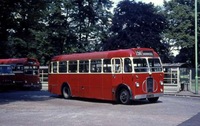 Vehicle reminder shot for this posting
Vehicle reminder shot for this posting
26/05/14 - 17:31
ECOC also operated a small number of 33str coach versions of the LC (LSC). In 1968 I bought WAH 875 (LSC 875) from Victoria Coaches, S’end for use in the Bickers of Coddenham fleet. It gave several years of good service. Ipswich Transport Society used it for the last day of Bradford trolleys. Flat out from Ipswich up the A1 overnight - filled up in Bradford with 7 gals! Axles were Austin / BMC, not Bedford.
Eric Mouser
Quick links to the - Comments Page - Contact Page - Home Page

